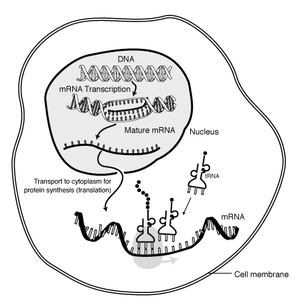In this lab, we asked the questions, "How does the body produce proteins and What kinds of mutations cause the greatest damage to the structure of a protein?" To answer these questions, we followed the steps of protein synthesis, throughout transcription and translation.
Protein production can be sorted into two main steps, with multiple substeps. First, a copy of the DNA (deoxyribonucleic acid) is made in a process called transcription, then the copy is used to make a protein, in translation. Proteins are essential to life. The first step of translation is for a section of DNA, known as a gene, to be copied by an enzyme, in the nucleus. The copy is called messenger RNA, often abbreviated as mRNA. RNA has a few main differences form DNA: It is only single stranded, and the base uracil replaces thymine. After the copy is made, the mRNA leaves the nucleus and travels to the cytoplasm. Then, translation beings - the mRNA bonds with a ribosome, which will make a protein. The ribosome reads the first three bases called a codon, and determines which amino acid corresponds with that sequence. Each amino acid that is determined by the codon is read by the ribosome. Amino acids are bonded together and when the mRNA is done being translated, the amino acid chain fold up to become a protein.

"Protein Biosynthesis." Wikipedia. Wikimedia Foundation, n.d. Web. 12 Dec. 2016. <https://en.wikipedia.org/wiki/Protein_biosynthesis>.
Of the mutations that we tested in this lab, I was able to conclude that each mutation could be nearly as harmful as every other mutation, depending on of the situation, the code, and when the mutations occur. We tested three types of mutations - substitution, insertion and deletion. The effect that substitution caused varied - only being extremely harmful when placed in a certain position. Otherwise, substitution is generally harmless. Insertion and deletion followed a similar pattern. When put near the start of the sequence, the change did quite a bit of damage, but when placed at the end, not much damage occurred.

"What Types of Mutation Are There?" Facts. The Public Engagement Team at the Wellcome Genome Campus, 25 Jan. 2016. Web. 12 Dec. 2016. <http://www.yourgenome.org/facts/what-types-of-mutation-are-there>.
When I chose my mutation I chose to replace the first G with the First T, as I wanted to see what happened if one of the early letters was changed. What ended up happening was that, the stop codon (UAA) was the second amino acid in the sequence, after MET, the start codon. This would have a devastating effect, especially if the protein was important, as it would not be able to make the protein. This shows why the place that the mutation is located can have a really big effect. Earlier in the lab we did a mutation at a different place in the same sequence and there was not a single effect on the amino acid sequence.

"What Types of Mutation Are There?" Facts. The Public Engagement Team at the Wellcome Genome Campus, 25 Jan. 2016. Web. 12 Dec. 2016. <http://www.yourgenome.org/facts/what-types-of-mutation-are-there>.
Because proteins are so essential to life as they play a part in almost every activity we do, mutations can sometimes be extremely harmful, especially if it greatly alters the amino acid sequence formed by the mRNA sequence. But it is also important to note that mutations happen often on a daily basis, and that most mutations are not as harmful. One example of a disease caused by mutations is phenylketonuria, abbreviate PKU. PKU is an incurable, chronic disease, that although rare, can cause great damage to the body. It is a birth defect that causes an amino acid called phenylalaline to build up in the body, which can lead to brain damage, intellectual disabilities, behavioral symptoms or seizures. PKU is an autosomal recessive disease caused by a mutated gene for the enzyme phenylalanine hydroxylase (PAH), which converts the amino acid phenylalanineto other essential compounds in the body.

"Phenylketonuria." U.S. National Library of Medicine. National Institutes of Health, n.d. Web. 12 Dec. 2016. <https://ghr.nlm.nih.gov/condition/phenylketonuria>.



Post a Comment